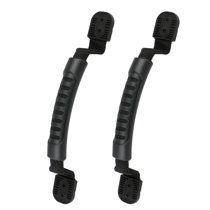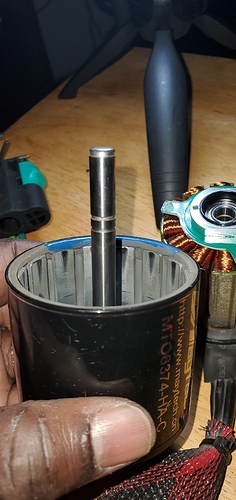You should “hope for the best, but expect the worst”. If something does go wrong dig for the root cause and fix it, don’t just replace components without at least doing diagnostics to know what failed and why. I’ve had a board go rogue from a pin coming loose from a signal line on the receiver and it started reporting full throttle signals (because the pin floated high), I fixed this after it happened in code for my receiver and of course physically fixed the issue, but especially when making custom parts and soldering all the connections yourself, if you lack experience you should not expect a solid reliable ride from your first crack at your first build, it may ride great for a month, but eventually you find the weak points of your build or the nut that wasn’t tight enough  .
.
Edit: Longest “sentence” of all time.
…so i have to learn python, or whatever, too. daaamn.
“hope for the best, but expect the worst” … hmm maybe i get an exway flex afterall 
guys, any hints where i should look if i want to buy alu cases / heatsinks for flipsky 4.12 controllers in eu ? doesnt matter if 2 single or one double
i watched maybe 2 of his vids, doesn’t seem to have done any diagnostics to find out what went wrong. he says the focbox still works though, maybe it was a loose componenent as happened to @wafflejock
I guess these things do happen as you say, im gonna locktite the shit out of the electrics when i finally build lol
Eh I mean if you have off the shelf components others have said are good and that let you set fail-safes and you test disconnecting various things while running low power (to see how things failsafe) and geared up then you should be fine, just more custom built stuff requires more caution. If you are the first to test the only prototype of your thing then you know, treat it that way is all.
Does the fsesc 4.12 have a Fail-Safe?
I think you best options are only flipsky and maytech but both of them are obviously not in the EU.
I guess you knew that already I don’t know any other option. Diy might help a tiny bit
It should anything using vesc firmware and tool for configuration you can set the timeout and adjust what it does in case it stops getting signal from the receiver (pretty sure default is 1s timeout with no receiver input then it goes to slight braking, or maybe idle I forget what is default but can set it, I think in general application configuration page but guessing). In my case I had made and programmed the receiver basically using rf-nano (I made the same myself with Arduino+nrf+custom PCB before RF-nano existed) and my receiver was the one sending a bad signal so vesc timeout didn’t help in my scenario but that’s unlikely unless you are making your own transmitter/receiver pair from scratch… Still point stands test and set the fail-safes where you can.
Does anybody know how to calculate the “Zugkraft” that the belts are dealing with?
In this case 15/72t 100kg 480mm belt (might have to ignore the wheels in this case)
Zugkraft = ?
if you’re trying to google english language resources, search for allowable working tension @xsynatic
yeah that didn’t help me finding what i need. 
I need a quick and dirty way of telling somebody what tension/strength/force whatever my belts are dealing with. Much like our esk8 calc.
I’m getting the same noise @Coreywolf has from Maytech MTO6374-HA-C. The scratch was from a while back (support bar). I just started hearing this noise maybe a week ago thought it was Idlers/bearing swapped those out…no joy
I guess you would need to know the peak instantaneous force applied, since your mass is constant the acceleration is the only thing that changes with regard to F=ma, so if you find peak acceleration it should correspond to peak Force (assuming it isn’t windy and negating drag, which isn’t much at low speeds anyway). Next part then would be figure out how to get from that forward motion Force to the torque on the wheel, and then can get from that torque to the belt tension I guess somehow… I’m sure it can be done but would need to bounce around a few physics forums to even get in the ballpark and would still be some rough guessing.
I have to carry my board up down a couple of stairs every day and need a grap handle that I can mount on the tail - any suggestions (prefer to rather carry it vertical than horizontal, since otherwise I ruin my pants within a week because of grip tape)?
My dictionary gave me “tractive force” for “Zugkraft”
Reference-design 4.12 controllers have no good place to put heatsinks for good effect. They dump heat right into the pcb from both sides, and no matter what kind of heat sink you put on, no matter where, you won’t get much of an improvement. It’s just how they were made.
I’d suggest looking for motors that have a skirt bearing to support that end of the can, such as the Turnigy SK3 and SK8, as well as some other “long and skinny” motors like the 5095s I saw floating around a while back.
If not that, it might be worth trying to go more for a “pancake” motor - Basically you want the can to either be supported, or not need support due to being shorter.
It’s one of the flaws of the outrunner motors we mostly use: On most, the rotor/can is only supported by on one side, and only then by a fairly skinny shaft. There’s a lot of mass there on the end of a significant lever. Serious bumps/impact or poor balancing can easily overstress that single support point.
Look up kayak carrying handles like this

They’re strong, light, and low profile. I found a 2 pack for $9. You could bolt them to your deck using the truck bolts or somewhere else that fits nicely.


